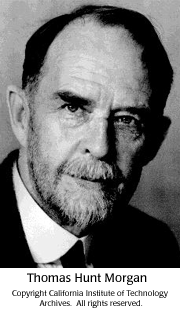Concept 10 Chromosomes carry genes.
 Thomas Hunt Morgan was one of the first true geneticists. He and his "Fly group" made tremendous contributions to our understanding of the role of chromosomes and genes in inheritance.
Thomas Hunt Morgan was one of the first true geneticists. He and his "Fly group" made tremendous contributions to our understanding of the role of chromosomes and genes in inheritance.
Thomas Hunt Morgan (1866-1945)

Thomas Hunt Morgan was born in Lexington, Kentucky. As a young boy, Morgan loved exploring the countryside collecting samples of wild life and fossils. At the State University of Kentucky, Morgan's course load was heavy in the natural sciences. In 1886, after graduating from State, he went to Johns Hopkins University, a relatively new school at the time, to do graduate work in zoology. His doctoral dissertation was a thorough and well-respected investigation of the embryology of sea spiders. From 1891-1904, Morgan was a professor at Bryn Mawr College where he taught biology and other natural science subjects. He continued his own research, and published books and papers on embryology and zoology.
In 1904, he was asked by his good friend, Edmund Wilson, to join the staff at Columbia University as Professor of Experimental Zoology. Morgan accepted, and so began the Drosophila chapter of Morgan's life.
Morgan had become interested in species variation, and in 1911, he established the "Fly Room" at Columbia to determine how a species changed over time. For the next 17 years, in a 16 X 23 ft. room, described by many as cramped, dusty, smelly and cockroach ridden, Morgan and his students did ground-breaking genetic research using Drosophila melanogaster, fruit flies. Though initially against the idea that the behavior of chromosomes can explain inheritance, Morgan became the leading supporter of the idea. Morgan and his students (Alfred Sturtevant, Calvin Bridges, Hermann Muller and others), developed the ideas, and provided the proof for the chromosomal theory of heredity, genetic linkage, chromosomal crossing over and non-disjunction.
Many who knew Morgan described him as an energetic, congenial man with a sense of humor and a flair for practical jokes. In the lab, Morgan was the ideas man and the planner, "the boss." He frequently left the details of planning the experiments to his "boys," his students. Morgan did do his share of work in the lab though he was resistant to the "new" equipment and methods that Calvin Bridges introduced, such as the binocular microscope. Morgan's data, often scribbled on the back of old envelopes or scraps of paper, were decorated with fly corpses. Morgan squashed "unwanted" flies rather than dumping them into the etherized morgue that Bridges set up.
In 1928, Morgan moved to Pasadena to organize the biology division at the California Institute of Technology. He became less involved with Drosophila work and returned to his earlier interests in embryology.
In 1933, Thomas Hunt Morgan received the Nobel Prize for Medicine for his work in establishing the chromosomal theory of inheritance. He shared the prize money with his children, and those of his long-time colleagues, Alfred Sturtevant and Calvin Bridges. Although Morgan officially retired from his position at Cal Tech in 1941, he continued to work in the lab until his death in 1945.


As an undergraduate, Thomas Hunt Morgan almost failed French even though he was a good student. His French teacher was a Union soldier and during the Civil War was captured by "Morgan's Raiders" — a troop organized by Confederate General John Hunt Morgan. The General was Morgan's great uncle.

Is it surprising that most of the Drosophila mutations found in the early years were X-linked traits?
 Children resemble their parents.
Children resemble their parents. Genes come in pairs.
Genes come in pairs. Genes don't blend.
Genes don't blend. Some genes are dominant.
Some genes are dominant. Genetic inheritance follows rules.
Genetic inheritance follows rules. Genes are real things.
Genes are real things. All cells arise from pre-existing cells.
All cells arise from pre-existing cells. Sex cells have one set of chromosomes; body cells have two.
Sex cells have one set of chromosomes; body cells have two. Specialized chromosomes determine sex.
Specialized chromosomes determine sex. Chromosomes carry genes.
Chromosomes carry genes. Genes get shuffled when chromosomes exchange pieces.
Genes get shuffled when chromosomes exchange pieces. Evolution begins with the inheritance of gene variations.
Evolution begins with the inheritance of gene variations. Mendelian laws apply to human beings.
Mendelian laws apply to human beings. Mendelian genetics cannot fully explain human health and behavior.
Mendelian genetics cannot fully explain human health and behavior.